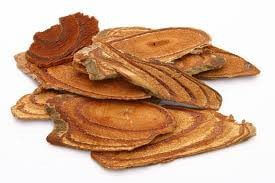Unlike many herbs in Traditional Chinese Medicine, recorded use of Spatholobus only goes back a few centuries. First mentioned in the 18th century text Bencao Gangmu Shiyi, the herb has had limited popularity. More recently, interest has picked up and so has its uses. Now it’s likely to be found in a variety of herbal medicines.
Traditionally, spatholobus is used as a tonic to promote circulation, soothe the joints and encourage a normal menstrual cycle. Some sources classify the herb as blood nourishing while others describe it as blood vitalizing.[1] Modern science has found new uses for it, especially related to the way it supports the blood.
Only the dried stem of the plant is used. According to Traditional Chinese Medicine, it works through the liver meridian.[2 Main active ingredients in spatholobus include plant sterols and flavonoids, specifically gallic acid, epicatechin, and several procyanidin B compounds.[3] Other compounds include saponins, polysaccharides, and triterpenes.[4]
Although it took a while for this herb’s health promoting properties to become well known, it’s healing properties are being explored for some of the world’s most challenging diseases, including cancer.[4] As this research continues, other studies have confirmed this relative new-comer to the pharmacopeia of Chinese Herbal Medicine delivers substantial health benefits. Here’s what researcher have found:
Spatholobus Acts as an Anticoagulant
Researchers have confirmed via animal studies that spatholobus has blood thinning properties. In lab tests, scientists observed that the herb reduced platelet activity and prevented blood clotting.[5]
Treats Anemia
Anemic conditions are another of the traditional uses for spatholobus as an herb that supports blood health. In one study, patients with severe aplastic anemia were given a blend that included spatholobus. Researchers reported the herbal combination worked for more than 50% of the patients, with nearly 20% being completely cured.[6]
Another study tested spatholobus as a way to regulate iron levels in the blood. Mice fed a diet featuring the herb experienced a 100% increase in serum iron, leading researchers to suggest the herb could be used as a therapy for iron deficiency anemia.[7]
Offers Antioxidant and Anti-inflammatory Protection to the Brain
In 2016, a study reported several different protective effects of spatholobus for the brain. The animals in the study that received the herb had higher levels of the antioxidant enzymes superdioxide dismutase and glutathione peroxidase. Cellular ATP increased as well. Together, these combined to protect brain cells from damage even when faced with ischemia and reperfusion injuries.[9]
Restores Blood Cell Counts
Spatholobus has been shown to not only boost but accelerate restoration of white blood cell, red blood cell and platelet levels.[10] A recent Chinese study reports that it also helps to improve survival rates in patients with acute myeloid leukemia.[11]
Promotes Healthier Joints
Another benefit involves protection for the joints. Researchers tested an extract of spatholobus to prevent bone loss. Although more research is needed to understand exactly how it works, the researchers discovered that the extract reduced the expression of factors related to osteoarthritis, supporting the herb’s traditional use to support the joints and tendons.[12]
References:
- https://chineseherbinfo.com/ji-xue-teng-millettia-or-spatholobus-root-and-vine/
- http://www.shen-nong.com/eng/herbal/jixueteng.html
- Huang, Y.; Chen, L.; Feng, L.; Guo, F.; Li, Y. Characterization of Total Phenolic Constituents from the Stems of Spatholobus suberectus Using LC-DAD-MSn and Their Inhibitory Effect on Human Neutrophil Elastase Activity. Molecules2013, 18, 7549-7556.
- https://chineseherbinfo.com/ji-xue-teng-millettia-or-spatholobus-root-and-vine/
- https://www.hindawi.com/journals/ecam/2016/2934340/
- Lee BJ, et al. Antiplatelet effects of Spatholobus suberectus via inhibition of the glycoprotein IIb/IIIa receptor. J Ethnopharmacol. 2011 Mar 24;134(2):460-7. doi: 10.1016/j.jep.2010.12.039. Epub 2011 Jan 4.
- Su EY1, et al. [Clinical observation of treating 62 patients with severe aplastic anemia failing in immunosuppressive therapy by integrative medicine]. [Article in Chinese] Zhongguo Zhong Xi Yi Jie He Za Zhi. 2012 Dec;32(12):1616-20.
- Guan Y1, et al. Screening identifies the Chinese medicinal plant Caulis Spatholobi as an effective HAMP expression inhibitor. J Nutr. 2013 Jul;143(7):1061-6. doi: 10.3945/jn.113.174201. Epub 2013 May 22.
- Zhang R, Liu C, Liu X, Guo Y. Protective effect of Spatholobus suberectus on brain tissues in cerebral ischemia. American Journal of Translational Research. 2016;8(9):3963-3969.
- Wang H1, et al. [Effects of heterogenous suberect spatholobus stem on peripheral blood cell counts of 60Co gamma ray irradiated mice]. [Article in Chinese] Zhong Xi Yi Jie He Xue Bao. 2007 Mar;5(2):189-92.
- Fleischer T, Chang T-T, Chiang J-H, Sun M-F, Yen H-R. Improved Survival With Integration of Chinese Herbal Medicine Therapy in Patients With Acute Myeloid Leukemia: A Nationwide Population-Based Cohort Study.Integrative Cancer Therapies. 2017;16(2):156-164. doi:10.1177/1534735416664171.
- Im NK1, et al. Spatholobus suberectus inhibits osteoclastogenesis and stimulates chondrogenesis. Am J Chin Med. 2014;42(5):1123-38. doi: 10.1142/S0192415X14500700.

